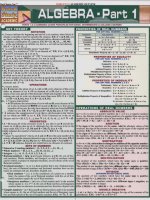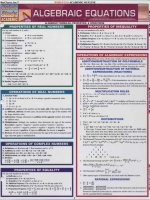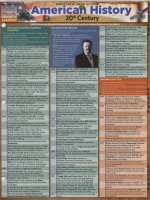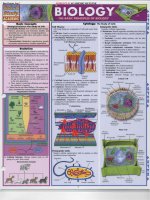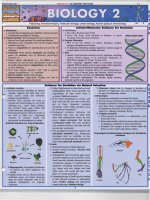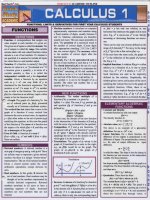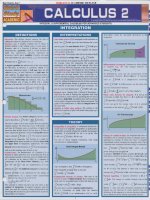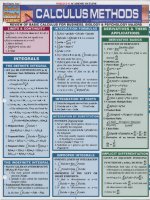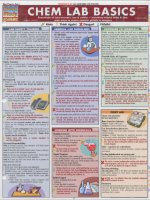- Trang chủ >>
- Khoa Học Tự Nhiên >>
- Vật lý
Quick study academic physics 600dpi
Bạn đang xem bản rút gọn của tài liệu. Xem và tải ngay bản đầy đủ của tài liệu tại đây (11.49 MB, 6 trang )
WHAT IS PHYSICS ALL ABOUT?
Physics seeks to understand the natural phenomena that
occur in our universe; a description of a natural
phenomenon uses many specific terms. definitions and
mathematical equations
Solving Problems in Physics
In physics, we use the SI units (International System)
for data and calculations
Base Quantity
Length
Mass
Temperature
Time
Electric Current
.;;;;;;S=;;=;;;=~T~he
position ofa
motion with position,
velocity and acceleration as variables; mass is the
measure of the amount of matter; the standard unit for
mass is kg. I kg = 1000 g.; inertia is a property of
matter, and as such, it occupies space
I. Motion along a straight line is called rectilinear;
the equation of motion describes the position of the
particle and velocity for elapsed time. t
a. Velocity (v): The mte of change of the displacement
. h'
()
s WIt
tIme ( t):v
cis = Tt
Ll s
= rlt
b. Acceleration (a): The rate of change of the
·
.h .
dv
Ll v
ve IoClty WIt tnne: a = dt = Tt
a & v'are vectors , with magnitude and direction
c. Speed is the absolute value of the velocity; scalar
with the same units as velocity
2. Equations of Motion for One Dimension (I-D)
Equations of motion describe the future position (x)
and velocity (v) of a body in terms of the initial
velocity (Vi), position (XII) and acceleration (a)
a. For constant acceleration. the position is related to
the time and acceleration by the following
x = vi, I ·1 ; a , t'
y = vi, ( + ;a, ('
2. For a rotating body, use polar
coordinates, an angle variable,
0 , and r. a radial distance from
the rotational center
C. 'lotion in TlJI'(~e Dimensions (3-D)
I. Cartesian System: Equations of
motion with x. y and z components
2. Spherical Coordinates: Equations
of motion based on two angles
((} and 'P) and r. the radial distance
from the origin.
m,M
T
t
I
position and velocity: F = m a OR ~ F = m a
3. Newton's 3rd Law: Every action is countered by an
opposing action
F:. 1 ~ pe\ of Forcc\
I. A body force acts on the entire body, with the force
acting at the center of mass
a. A gravitational force. Fg. pulls an object toward
the center of the Earth: Fg = mg
b. Weight = Fg; gravitational force
c. Mass is a measure of the quantity of material ,
independent of g and other forces
2. Surface forces act on the body's surface
a. Friction. Fe. is proportional to the force normal to
the part of the body in contact with a sUlface,
="
Fn·: Fr
Fn
i. Static friction resists the
move-ment of a body
ii. Dynamic friction slows
the motion of a body
For an object on a
horizontal plane:
F f = Il Fn = ll m g
Net force = FI - F f
Polar: (r, 9)
x = r cos9, .
y = r sin9,
----r-
Circular Motion
....
(}
%,
Radian
Radian/second
a
Radian/second 2
s
Meter
W
= F d cos (8) = F
F__
D
• r
F_ _
r
D
Maximum work
r
p = LlWork = LlWork
Ll t
f P(t)dt
The Sl unit for power is the Watt (W):
I W = I Joule/second = I J/s
Work for a constant output of power:
W = P Lit
Energ~
&
Enrrg~
Consenation
I. The total energy of a body, E, is the sum of kinetic.
r
.
The angle between rand
the (x) axis
te
angular velocity
The angular acceleration
The circular motion arc
s = r8 (8 in rad)
3. Tangential acceleration & velocity:
v , = rw; a , = r a ; v and a along the path of the
K, & potential energy. U: E = K +:Eu
2. Potential energy arises from the interaction with a
potential from an external force
Potential energy is energy of position: U(r); the form
of U depends on the force generating the potential:
Gravitation: U(h) = mgh
.
q,q,
Electrostatic: U (r,,) = '"'"F;;
If there are no other forces acting on the system, E is
constant and the system is called conservative
I. Collisions & Linear 'loml'lItulll
Collisions
I. Types of Collisions
a. Elastic: conserve energy
b.lnelastic: energy is lost as heat or
deformation
2. Relative Motion & Frames of
Reference: A body moves with vc:locity v in frame
S; in frame S' the velocity is v' ; ifYs' is the velocity
of frame S' relative to S, therefore: v = V,' + v'
3. Elastic Collision
Conserve Kinetic Energy:
t m v ,' = t m vI
L:
motion arc
4. Centripetal acceleration: a ,. =
v'
r;
a is directed
toward the rotational center
a. TIle centripetal force keeps the body in circular
motion with a tangential acceleration and velocity
1
No work
4. Power (P) is energy expended per unit time:
II. Potrnthll
distance from the
rotation center (center of
mass)
z
Newton's Laws are the core x = r simp cos9,
principles for describing the motion y = r sinep sin9,
z = r coslj),
of classical objects in response to
r2=x2 + y2+z2
forces. The SI ullit of force is the
Newton, N: IN=lkg m/s2 ; the cgs unit is the dyne: 1
dyne = I g cm/s2
~
1,- 0
I The
I Meter
r
J
Work =
2. Key Varia_b_le_s_: _ __ , _ _ _._ _ __ _---.
I
energy is the energy of
motion ; mass. m and velocity. v: K = t mv'
The SI energy unit is the Joule (J):
\J = I kg m 2/s 2
2. Momentum, p: Momentum is a property of motion,
defined as the product of mass and velocity: p = m v
3. Work (W): Work is a force acting on a body moving
a distance; for a general force. F, and a body moving
a path , s: W =
F ds
For a constant force. work is the scalar product of
the two vectors: force. F. and path. r:
Ll time
Fn
polar coordinates: (r,8)
r2=x 2 +y2
x
Dynamk Friction
F. Circular 'lotion
I. Motion along a circular path uses
~,
Spherical
Other physical quantities are derived from these basic units:
Prefixes denote fractions or multiples of units; many variable
symbols are Greek letters
Math Skills: Many physical concepts are only understood
with the use of algebra, statistics, trigonometry and
calculus
Unit
Meter - m
Kilogram - kg
Kelvin - K
Second - s
Ampere - A (C/s)
/, x
1. Newton's 1st Law: A body remains
motion unless influenced by a force
2. Newton's 2nd Law: Force and acceleration
determine the motion of a body and predict future
equation of motion: x (I) = X u + V i ( + t ar
b. For constant acceleration. the velocity vs. time is
given by the following: v r(t) = V i + at
c.lf the acceleration is a function of time, the
equation must be solved using a = aCt)
R. 'Iotioll ill 1\\0 Dimcnsiolls (2-0)
I. For bodies moving along a y Polar
straight line. derive x- and y
equations
of
motion
Symbol
Conserve Momentum:
Lm
Vi =
L:
L rn Vr
~
4. Impulse is a force acting over time
Impulse = F Ll t or
f F (t) dt
Impulse is also the momentum change:
z
Pfin - Pini!
.1. Rul:ltiulI 411 a Rigid Bud~
I. Center of Mass: The "average" position in the
body, accounting for the object's mass distribution
2. Moment ofInertia, 1: The moment ofinertia is
a measure of the distribution of the mass about
the rotational axis: ~ rn, r,'
rio is the radial distance from mj to the rotational axis
Sample I for bodies of mass m:
rotating cylinder (radius R): +rn R'
M.
O,cillatur~ Motion
I. Simple Harmonic Motion
a. Force: F = - k..1 x (Hooke's
Law)
b. Potential Energy: Uk = + k..1 x'
c. Frequency of the oscillation:
T
Rotating Bodies
Law
Spring
T
= 21l'jI
nr,
b. Frequency of oscillation:
f=..L
Simple
Pendulum
!K
21l'V T
\.
L = Iw = r • P =
f r • v dm
Torque is also the change in L with time:
T=r'F=~7
h:. Static E(llIilihrium &
Angular
Momentum
Elasticit~
t
1. Equilibrium is achieved when:
~f = O
, 0~
~T = O
~
The body has no linear or angular
acceleration
2. Deformation of a solid body
a. Elasticity: A material returns to its original
shape after the force acting on it is removed
b. Stress & Strain
i. Strain is the deformation of the body
ii. Stress is the force per unit area on the body
c. Hooke's Law: The stress IS linearly
proportional to the strain; stress = elastic
modulus x strain:
i. Linear Stress:
Young's Modulus, symbolized Y
ii . Shape Stress:
Shear Modulus, symbolized S
iii. Volume Stress:
Bulk Modulus, symbolized B
L lIniH'rsal (;nl\ itatiull
...._......_._......... r ......_ . ...........................,
M 1 ...
Universal Gravitation
...
M2
1. Gravitational Force & Energy
a.
. . I energy: U,= -GM,M,
GravltatlOna
-r-
GM,M,
. . I rlorce: F, = ~
b. Gravltatlona
Fg is a vector, along r, connecting M J and M2
c. Acceleration due to Gravity, g: For an object on
the Earth's surface, Fg can be viewed as Fg
=m
g; g is the acceleration due to gravity on the
Earth's surface: g = 9.8 m1s 2
Hooke's
2. Simple Pendulum
a. Period of oscillation:
rotating sphere (radius R): trn r'
T = la = r • f (angular acceleration force)
5. Angular momentum is · the momentum
associated with rotational motion:
u mll
f=..L Ik
21l'V m
twirling thin rod (length L): ,', rnL'
3. Rotational Kinetic Energy = +LQ'
The rotational energy varies with the rotational
velocity and moment of inertia. I
4. Angular force is defined as torque, T:
~.
Ful'l'~s in Solids & Fluids
I. p , the density of a solid, gas or liquid:
p = mass/ volume = M/V
2. Pressure, P, is the force divided by the area of
the forces acted upon: P = forcelarea
The SI unit of pressure is the Pascal, Pa:
I Pa = 1 N I m 2
a. Pascal's Law: For a
Pascal's Law
fluid enclosed in a vessel,
the pressure is equal at all
points in the vessel
b. Pressure Variation with
Depth
Pf The pressure below the surface of a liquid:
P, = PI + pgh
h is the depth, beneath the surface
p is the density of the water
PI is the pressure at the surface
Pressure
Variation
,-,.-.,.,..,.,.,.,.,,,.......==1.....,..,,......,..,.....,.'".,... Surface
Liquid
P Pl
h
c. Archimedes' Principle: An object of volume
V immersed in liquid with density p, feels a
buoyant force that tends to force the object
out of the water: g, = p V g
Earth's
Archimedes'
Principle
,,\.\I\i{fWV""hXXhhH omAA""""
Surface
Liquid
3. Examine Fluid Motion & Fluid Dynamics
a. Properties of an Ideal Fluid
i. Nonviscous - minimal interactions
ii. Incompressible - the density is constant
iii. Steady flow - no turbulence
iv. At any point in the flow, the product of area
and velocity is constant: AI VI = Al VI
b. Variable Fluid Density
If the density changes, the following equation
described properties of the fluid:
p,A,v, = p,A,v,
Variable Fluid
Density
c. Bernoulli's Equation is a more general
b. Weight is the gravitational
description of fluid flow
force exerted on a body by the
i. For any point y in the fluid tlow:
P + +p v' + p g y
constant
Earth: Weight = Fg = mg
Weight is ill!! the same as mass
=
Gravitational
Potential
Energy
01 \\a,cs
•Transverse
·Traveling
• Harmonic
• Longitudinal
• Standing
• Quantum mechanical
1. General fonn for a transverse OR traveling wave:
y = fix - vt) (to the right) OR y = f(x + vt) (to the leli)
2. General form for a harmonic wave:
y
A sin (kx - w t) OR
Standing '\
=
y = A cos (kx - w t)
3 Standing Wave: Multiples of ,1/2 fits
the length of the oscillating material
4. Superposition Principle: Overlapping
waves interact => constructive and
destructive interference
a. Constructive Interference: Thc
wave amplitudes add up to produce a
I ).
wave with a larger amplitude than
either of the two waves
Harmonic ~ave
b. Destructive Interference: The
wave amplitudes add up to
produce a wave with a smaller
amplitude than either of the two
waves
B. lIarnwnk \\:I'l' Propertil's
Wavelength
A (m)
Period
T (sec)
Frequency
f(Hz)
Angular
Frequency
w (rad/s)
Wave
Amplitude
A
Speed
Distance between cycles
Cycles per ,eeond: f - IT
r::
=
21l'/ T =
2m
Height of wave
1
I v (m/s)
Linear velocity v = Af
C. Sound \\ aH',
1. Wave Nature of Sound: Sound is a compression wave that
displaces the medium carrying the wave; sound cannot tra, el
through a vacuum
2. General Speed of Sound: v =
~
b. p is the density
3. For a Gas: v =
gravitational
potential => Ug = mgh
T~fI~S
A . Esampfl's 01
a. B is the bulk modulus, the volume compressibilit. of
the solid, liquid or gas
2. Gravitational Potential Energy, Ug
a. The
WAVE MOTION
ii.For a fluid at rest (special case):
P,-P,=pgh
2
J,r RT
M
r = Cp/C,· (the ratio of heat capacities)
4. Loudness - Intensity & Relative Intensit~·
Loudness (sound i11lensity) is the power carried by a
sound wave
a. Relative Loudness - Decibel Scale (dB):
P(dB)
=
10 log
(f.)
i. The decibel scale is delined relative to the threshold
of hearing, I,,: P(I,,) = 0 dB
ii. A change in 10 dB, represents a lOx increase in sound
intensity, I
b. Doppler Effect
The sound frequency shifts (f'/t) due to relative motion of
the source of the sound and the observer or listener: Vo
speed of the observer; vs
Doppler Effect
speed of the source;v
speed of sound
O => <=S
i. Case I: If the source
of sound is
approaching the
observ.::r, the
frequency increases:
ii. Case #2: If the source
of sound is moving
away from the
observer, the
L
_ (~)
<=0 s =>
frequency decreases:
f
\ + \,
~j
'i~t'to.t~~l"".CiljJi.
THERMODYNAMICS
.
Thermodynamics
Thermodynamics is the study
of the work. heat & energy of a
process
Q
~
Heat: Q
+Q added to the system
Work: W
+W done by the system
Energy: E
System intemal E
Enthalpy: H
H
Entropy: S
Thermal disorder
-
----
E+ PV
=
I Measure of thermal E
Temperature: T
Force exerted by a gas
Pressure: P
Volume: V
Space occupied
I. Thermodynamic variables are variables of state
and are independent of the process path; other
variables are path-dependent
2. Types of Processes: Experimental conditions can be
contro lied to allow for di fferent types of I'W"""'"
r
Thermodynamic
Condition Constraints
Result
~T
Isothermal
I ~E
Q=0
Adiabatic
No heat flow
I
!
~P
= -w
~
against P ext; gas expands from V I to V 2 using an
infinite number of steps; the system remains in
V= 0
~H =
Q
~E =
Q
w=
Fixed volume
0
O.
measures thermal energy
T(K) = T (OC)
+ 273.15
T is always in Kelvin, unless noted in the equation
b. Z e roth Law of Thermodynamics: If two
bodies. # I and #2. are separately in thermal
equilibrium with a third body, #3, then # 1 and #2
are also in thermal equilibrium
2. Thermal E xpansion of Solid, Liquid or Gas
a. Solid: tL
= a LIT
= /3 LI T
c. Gas: LI V =
(T, - T,)nR
,
- p
(Charles Law)
3. Heat C apacity, C
C depends on LI l' and Q, the heat lost or gained:
C
= LI<;'
OR Q
b. Molar heat capacity is C per mole
i. Heat capacity for constant pressure, C p :
LI H is the key variable
ii . Heat capacity for constant volume, C.:
LI E is the key variable
d. ldeal Gas:
5
3
C" = 2'R AND C, = 2'R
i. The ratio of these two heat capacities is called y
ii.For Ideal Gas:
r=
g~
=
i = 1.667
2. Equations for Energy of an Ideal Gas:
3
E = M v' and E = 2' RT
+
a. Average Speed of a Gas Molecule:
~
b. Gas
+ PV
~H =
~
E
+P~V
=
ii .Exothermic: Negative ~ H; the system releases
heat to the surroundings (EX: combustion of fuel,
condensation of vapor to liquid)
Transitions:
s olid
+-
liquid
+-
gas
ii. Enthalpy of fusion: ~ H,,,,
c. Enthalpy & Variable Temperature:
= jCpdT
For constant C p : ~ H =
4. Examples of Work: W =
C. ~ T
j PdV
a. P opposes the ~ V for an expansion; P causes the
~
v "". ,
V for compression; W depends on the path
b. Single step isobaric expansion from V I to V 2
against
an
opposing
pressure,
Pext '
V{T;
1";'
!l:r
F.
F:1l'ro(l~
& 2nd I.a\\ of
rhenll(l(l~
Ita m ics
The 2nd Law of Thermodynamics is concerned with
the driving force for a process
I . Entropy. S
Entropy measures the thermal disorder of a system:
dS -- dQ
T
like E &
is a state variable,
~ S (universe)
=
~ S (system)
~
+
H:
S (thermal
reservoir)
2. 2nd Law of Thermodyna mics:
spontaneous process. ~ s,,""
for
a
system
at
equilibrium or for a reversible
process
3. Examples of Entropy Changes
For
~
any
>0
S,,"h = 0
a. Natural Heat Flow: Heat flows
from Thot to Tcold
b. Entropy & Phase Changes:
LlS(changc)
LI H (change)
=
Q
~
Heat Flow
T( h
c a nge )
solid --. liquid
positive ~ S
~ S,...
liquid
positivI.' ~ S
~ S"p
-+
solid
c. Entropy & Temperature for an Ideal Gas:
SeT): LIS = nCpln( i : )
Increasing T increases the disorder
d . Entropy & Volume for an Ideal Gas
A gas expands from V I to V~ :
S(V):
~S
= n
R In(~: )
The disorder of a gas increases if it expands
3
IS
change from TI to T2
e. For a Real Gas: Add heat capacity and energy
terms for molecular vibrations and rotations
Entropy
a. ~ H
Q for a process at constant pressure; the
di fference between E and H is the work
performed by the process
b. Phase
Temperature:
IT ; a
K -
- lRT
2
= Q- W
determined by the difference between the heat
gained (Q) by the system and the work performed
(W) by the system on the mechanical surrounding
3. Enthalpy, H
Enthalpy is a new state variable derived from the 1st
Law of Thermodynamics at constant pressure:
H = E
&
Speed
d. Kinetic Energy for 1.00 Mole of an Ideal Gas:
E is independent of path
~E
/3~T
V n ", =
& I st Lan of Thumod~ l1amics
I. Wand Q depend on path of the process; however,
~H
c. Two special experimental cases:
E. rhl' Kinetic rhe()r~ of Gases
I . Gas particles of mass, M, are in constant motion,
with velocity. v, exerting pressure on the container
El1lhalp~
i. Enthalpy of vaporization: ~ H ...
a. Specific heat capacity is C per gram
V
c. Gas Speed & Mass: v,,'" is proportional to
A phase change corresponds to a change in enthalpy:
= CLIT
p..
changes the speed by
i. Endothermic: Positive ~ H ; the system absorbs
heat from the surroundings (EX: evaporation of
liquid to gas; melting of a solid)
b. Liquid: LI:
PL'
Temperature(K)
2. lst Law of Thermodynamics:
a. The SI unit is Kelvin. absolute temperature:
SIa&Ie Step EspDIIoa
proportional to
a. The change in energy of the system (~ E ) is
I.
process gives the maximum work
IL
Pressure (Pa)
W = P~V
= 0
equilibrium: W = n RT In (~: ) . This type of
Charlet' Law
~~
PV' = constant
Fixed pressure
Isochoric
Carnot's Law is exact for monatomic gases; it
jl\ -,...
-Isobaric
c. Reversible, isothermal expansion of an Ideal Gas
-
must be modified for molecular gases
C. Ideal Gas L:m: P\ = 11 R I
I. The Ideal Gas Law
a. Pressure, P: The standard unit is the Pascal (Pa), but
the bar is more commonly used: I bar = 105 Pa
b. Volume, V: The standard unit is the m 3, but the
liter, L. is more common: I L = I dm 3
c. Temperature, T: The standard temperature unit is
absolute temperature, the Kelvin scale: T(K)
d. Amount of gas, n: # of moles of gas (mol)
e. R is a proportionality constant, the gas constant,
given the symbol R : R=O.083 L bar mol-I K-I
2. Applications of Gas Laws
a. Boyle's Law (constant temperature, T): Pressure
is proportional to I/volume
b. Pressure is proportional to temperature, with
volume fixed
c. Charles' Law (constant pressure, P): Volume is
proportional to temperature
d. Avogadro's Law (constant P and T) : Volume is
proportional to the # of moles, n
e. General Ideal Gas Law Application
i. Use PV = n RT to examine a gas sample under
specific conditions ofP,V. nand T
I ~E = O, Q = w
= 0
C. = R
e. Carnot's Law: For ideal gas: C p
W
Thennocl namics
I. Thermal Engine: A heat
engine transfers heat, Q,
Il(
from a hot to a cold
reservoir, to produce
work. W
a. The I st Law of
Thermodynamic states
that the work, W. must Q...w
equal the di fference
between the heat terms:
W=
2. The efficiency of an engine. 7J, is defined as the
ratio ofW divided by
Qhot: 7J
CanotCyde
p
= QW
"",
3. Idealized Heat Engine: The Carnot Cycle
a. The Carnot Cycle consists of two isothermal
steps and two adiabatic steps
i. For overall cycle:
T.
t. T
n, t. H = 0 and t. S = 0
~
AT - O
i:
b. Camot Thermal Efficiency = 7J = 1
Qhot - QCOld
T.
~-----------------v
ELECTRICITY. MAGNETISM
r----- r ------,
c. For a material with dielectric constant K:
Electric FIelds &; Eleetrle Charge
\. Electric Fi~lds & Electric Char:.:e
Examine the nature of the field generated by an
electric charge and the forces between charges
I. Coulomb, given the symbol C, is a measure of
the amount of charge:
I Coulomb = I amp· I sec
e is the charge of a single electron :
e = 1.6022 x 10-19 C
2. Coulomb's Law for electrostatic force, Fcoul :
F
1 q,q,
= 41r€o
rou'
--r;- r
3. Electric Field, E, is the potential generated by a
charge that produces Fcoulon charge qo:
I. A capacitor consists of two separated electrical
conducting plates carrying equal and opposite
charge. A capacitor stores charge/electrical
potential energy
2. Capacitance, C. is defined as the ratio of charge,
Q, divided by the voltage, V, for a capacitor:
C
V is the measured voltage; Q is the
charge
a. Energy stored in a charged capacitor:
' Q'
c
= ,.
=
t QV
KV'
=
b. Parallel plate capacitor, with a vacuum,
with area A, and spacing d :
E -- F...:
qo
u'
4. Superposition Principle: The total F and E have
contributions from each charge in the system:
. C
'
C=
apacltance:
I.
.0"
dA
ii. Energy Stored:
U
R. Sources flf Electric Fields: Gauss's La\\
I. Electric flux, (/J.. gives rise to electric fields and
Coulombic forces
2. Gauss's Law: (1),.
=f E
• dA
=~
The electric flux, cp, • depends on the total charge
in the closed region of interest
C. Electric "otential & Coulflmhic Ener:.:~
I. Coulombic potential energy is derived from
Coulombic force using the following equation:
f
U roo' =
F"." dr
a. Coulombic Potential Energy:
1 qq'
U e,.,ul = 4Jreor
b. Coulombic PotentiaWoltage
i. The Coulomb potential, V(q), generated by
q is obtained by di viding the Ucoul by the
test charge, q':
U
=
V (q) - U - _1_3.
- q'
47[.011 r
=
-
t CII AdE'
3. The Dielectric Effect
a. Electrostatic forces and energies are
diminished by placing material with dielectric
constant K between the charges
b. Voltage and electrostatic force (V & F) depend
on the dielectric constant, K
V
T
b. The SI resistance unit is the Ohm. ,Q
1 h
0
m
( n) =
0&
PanIIeI Plate Capacitor
E =.Y.=..JL
d
c"A
c. ParaUei plate capacitor,
dielectric material with
dielectric constant K,
with area A. spacing d:
C
=
Kc" A =
d
. f'
"'--II
1 = ,,1
-c
L... C.
101
I
iii. Capacitors in Parallel: C ", = ~ C
Two Capadton In Series
Two Capaciton In PanDel
~C' i C2 j
.,
Capadtan In CIreuIIi
E. Current & Resistance: Ohm's L:m
I. Current & Charge: The current, I, measures the
charge passing through a conductor over a time;
total charge, Q: Q = I • t
4
a:
0.
4. ReSistivity: The inverse of conductivity is
resistivity, given the symbol p : p
=
1
5. Voltage for current I flowing through a
conductor with resistance R: V = IR
6. Power Dissipation: Power is .Iost as 1 passes
through the conductor with R:
Power =VR = 12 R
7. Resistors in Circuits: Certain groups of
resistors in a circuit are found to behave as a
single resistor
b. For resistors in parallel:
=
L
R
i,,,, - ~ A,
&
C, = vacuum capacitor
i. Capacitors in Circuits: A group of
capacitors in a circuit is found to behave like
a single capacitor
" . Capacltors
"S
'
II
IRerles:
w
u
Ivolt(V)
1 amp (A)
a. For resistors in series: Rio,
V(q)q '
q
_1_fd
47[.00
r
by the current: R =
iii . Electric Field:
c. For an array of charges, qj' V",", = LV,
2. Potential for a Continuous Charge Distribution:
V-
conductivity: J = IJE
3. Resistance
a. The resistance, R, accounts for the fact that
energy is lost by electron conduction ;
resistance is defined as the voltage divided
c.
= ~;
U
2. Ohm's Law: Current density, J, is in
proportion to the fi eld; IJ is called the
F, Ilin'ct ( urn'nt ('il'cuit (1)( )
I. Goal: Examine a circuit containing battery.
resistors and capacitors; determine voltage and
current properties
2. Key Equations & Concepts
EMF: The voltage of a circuit is called the
electromotive force, denoted emf
a. This voltage accounts for the battery, Vb' and
the
circuit
voltage,
denoted
IR :
emf=Vb + IR
b. The battery has an internal resistance, r:
Vb =1 r
3. Circuit Terminology
a. Junction: Connection of three or more
conductors
b. Loop: A closed conductor path
c. Replace resistors in series or parallel with
RIOt
d. Replace capacitors in series or parallel with
Ctot
4. Kirchoff's Circuit Rules
a. Constraints on the Voltage
i. For any loop in the circuit the voltage must
be the same:
LV = LIR
ii. The energy must be
conserved in a circuit loop
b. Constraints on the Current
i. The current must balance at
every node or junction
ii.For
any
junction :~"
--<
LI
ii.For a closed current loop: F = 0
3. Magnetic Moment
A magnetic moment, denoted M, is produced
by a current loop
a. A current loop, with current 1 and area A,
generates a magnetic moment of strength M :
M=IA
b. Torque on a loop: A loop placed in a
magnetic field will experience a torque,
6. Gauss's Law: The net magnctic flux through any
closed surface is always zero:
f B • dA =
0
a. Gauss's Law is based on the fact that isolated
magnetic poles (monopoles) do not exist
I. I' arada~', I.a\\ - J' ll'ctrol1la~nctic Induction
Faraday's Law: Passing a magnet through a
current loop induces a current in the loop
Faraday' Law
rotating the loop: r = M • B
= 0
iii. The total charge must be conserved in the
circuit; the amount of charge entering and
leaving any point in the circuit must be
equal
( •.
'Ja~lIl'1k
J kid . 1\
I. Magnetic Field: A moving electric charge or
current generates a magnetic field, denoted by
the symbol B; the vector 8 is also called the
magnetic Induction or the magnetic nux
density
a. The SI unit for a magnetic field is the Tesla, T
b. The SI unit for magnetic flux is the Weber, Wb
Wb
N m
N
IT = Ill' = C . s = A • m
I. Faraday's Law of Induction
magnetic flux,
~ """LIBeI
Z
.n'_
the
interaction
of
Band
M:
U (magnetic) = - M • B
5. Lorentz Force: A charge interacts with both E
and 8, the force is given by the following
expression: F = q E + q v • B
a. Band E contribute to the force
b. The particle must be moving to interact with
the rna etic field
a. Given the current I and the conductor segment
of length dl, the induced magnetic field
contribution, dB, is described by the
III
A.
passing through the circuit:
a. Special Case: Uniform field 8 over loop of
area A;
EMF =
B
is the angle formed by dA and 8:
d:
(BA cos 8)
b. Motional EMF: Moving a conductor of
length I through a magnetic field 8 with a
speed v induces an EMF (8 is perpendicular
to the bar and to v): EMF = - B I v
c. Lenz's Law: The direction of the induced
current and EMF tends to maintain the
original flux through the circuit; Lenz's Law
is a consequence of energy cbnservation
Eleetremapede Wave
p"ldI'r
.
followmg: dB = 41!' --r
a
b. The total magnetic field for the conductor is
~
e. For a current loop, the field is generated by
the motion of the charged particles in the
current.
pojdl'r
.
gIven by: B = 41!'1 ~
2. The magnetic field strength varies as the
inverse square of the distance from the
conducting element
3. Special Case - Infinitely long straight wire:
B (a) = : ;
i ;a is the distance from the wire;
I is the current; B, is inversely proportional to a
I
BIot-savart Law
B
velocity,
v,
in
magnetic
field
0, minimum force)
ii.For v perpendicular to
Z
a
4. Ampere's Law: For a circular path around wire,
=
B; F = q v B ( B = 7[/2,
a
"---->-..... A
maximum force)
RlPt-llaDd
iii. The "right hand rule"
Rule
defines the force direction
b. Force on a conducting segment: For a current
I passing through a conductor of length I in a
magnetic field B, the force is given by:
F=II· B
i. For a general current path s:
F=ljds.B
.
E
B
= c
b. The speed of light, c, correlates the magnetic
constant, 11", and the electric constant,
. _ _ 1_
Cu.c-
IlloE!)
speed oflight, c: c = fA
d. X-rays have short wavelength, compared with
radio waves
e. Visible light is a very small part of the spectrum
F .... = q v·B = qvB sin 8
(B
.
followmg equatIOn:
wavelength, ..t ,and frequency, f, travels at the
B:
a. B is the angle between
vectors v and 8
i. For v parallel to B; F = 0
I. Electromagnetic wa ves are formed by
transverse 8 and E fields
a. The relative field strengths arc defined by the
c. In a vacuum, an electromagnetic wave. with
2. Magnetic Force: F mag on charge, q, moving at
III
A.
Q)""
EMF = fEds AND EMF = -~tl/)m
4. U (magnetic): Magnetic potential energy arises
from
c. The CGS unit is the Gauss, G: 1 T = 104 G
d. For a bar magnet, the field is generated from
the ferromagnetic properties of the metal
forming the magnet
i. The poles of the magnet are denoted
North/South. The field lines are show in the
figure below
The EMF induced in a circuit is directly
proportional to the time rate of change of the
Torque OD a Loop
the total of the magnetic flux, B . dS, must be
consistent with the current, I:
f B • dS = Po I
5. Magnetic Flux, 1/)",
Summarize the general behavior of electrical and
magnetic fields in free space
I. Gauss's Law for Electrostatics:
fE. dA =
~
2. Gauss's Law for Magnetism:
a. The magnetic flux, 1/)"" associated with an
area, dA, of an arbitrary surface is given by
the following equation:
I/)m =
j
B • dA;
dA is vector perpendicular to the area dA
b. Special Case - Planar area A and uniform B at
angle I with dA: I/)m = B A cos B
5
fB'dA=O
3. Ampere-Maxwell Law:
f B • ds = p"I + p"e" ~~"
4. Faraday's Law: f E • dS =
-
~~..
I. Light exhibits a duality, having both wave
and particle properties
2. Key Variables
a. Speed of light in a vacuum, c
b. Index of refraction, n:
The index of refraction, symbolized n, is
the ratio of the speed of light in a vacuum
divided by the speed of light in the material:
c (vacuum)
n= c (material)
c. View light as a wave--Iocus on wave
properties: wavelength and frequency
i. For light as an electromagnetic wave :
Af
=c
ii. Light is characterized by its wavelength
("color"), or by its frcquency, f.
d. View light as a particle in order to
o
- .~--~'-
N
Images & Objects
frequcncy, f, with the proportionality
constant
h,
Planck's
Constant:
E (photon) = h f
3. Reflection & Refraction of Light
Renection of Light
Incident
Ray
\"2
2. Lenses and mirrors are characterized by a
number of optical paramcters:
u. The radius of curvature, R, defines the
shape of the lens or milTor; R is two times
the foca l lengt h, f: R = 2 f
i+ Sign
Parameters
::j '"'"g;",
t.,
f foca l length
I--
s obj ct
distance
-
Y
diverging
lens
convex
mirror
virtual
image
erect
inverted
h' image size
erect
inverted
=
I
speed bends the
light ray as it
passes from n I
to 11 2
i. The angles of the incident and relracted
rays are governed by Snell's Law:
n, sin 8,
n , s in 8,; n l, n2: indices of
retraction of two materials
. 0
n ·,
c. Internal Reflectance: SID "
n; ; Light
=
=
passing fromlllaterial of higher n to a lower
nmay be trapped in the material if the angle
of incidence is too large
4. Polarized Light: The E tield of th.:
electromagnetic wave is not spherically
symmetric (EX: plane (linear) polarized light,
circularly polarized light)
a. One way to generate a polarized wave is by
retlecting a beam on a surface at a preci se
angle , called B,
b. The angle depends on the relative indices of
refraction and is defined by Brewster's
n·,
Law: tan B, =
n.
b. The optic axis: Line from base of object
through center of lens or mi rror
c. Magnification: The magnifying power of a
*
lens is given by M, the ratio of image si ze
to object size: M =
d. Laws of Geometric O ptics
i. The m irror equ ation: The focal length,
image distance and object distance are
described by the following relationship:
1
1
~
Q)::J.
C)
~ :::I
a'
;:;
w
a:0.
=
a, ...)
d sin B
mA, (rn
0, 1, 2,
4. Single Slit Experiment:
For a wave passing through a slit of width a,
destructive interference is observed for:
=
=
sin ()
rnA / a, (m
0, ± 1, ± 2, ... )
5. X-ray difi'raction from a crystal with atomic
spacing d gives constructive interference lor:
2 d sin B = rnA,
(rn
= 0, I, 2, a....)
Fundamental Physical Con tanh
Mass of
Electron
Mass of Proton
ii. The object and image distances can also be
used to detennine the magnification:
h
"S'=-1l'=M
C.
ill
lli
1
s+"S' =y
s
ill
:)i
z«
C)
c. Huygens' Principle: Each portion of wave
front acts as a source of new waves
3. Diffraction of light from a grating with
spacing d produces an interfer~nce pattern
governed by the following equation:
-
+-
al
'Cc U
Destructive Interference
h obj ect size
- OE
gJU
«$>~"
",0 :::1
~~
--
=
+ y,
virtual
object
s' image distance real image
a. Law of Reflection: For light rcfkcting
from a mirrored surface, the incident and
retlected beams must have the ame angle
with the surface nOl1nal: 0,
0,
b. Refraction:
Li ght changes
Refraction of Light
speed
as
it
pa sses through
materials with
ditTcrent indices
of refraction;
this change in Glass
y = y,
)
J't
'bj,"
-
~x
Constructive Interference
- sign
lens
concave
mirror
o
b. Destructive interference occurs when
wave amplitudes add up to produce a new
wave with smaller amplitude than either of
the component waves: the wave amplitudes
cancel out
LeD II. Mirror Properties
i. Energy is quanti zed in packet s called
ii. The energy of photon de pends on the
- ~ --"'-----:l
.. ~
understand the energetic properties of light
photons
2. Key Variables & Concepts
a. Constructive interference occurs when
wave amplitudes add up to produce a new
wave with a larger amplitude than either of
the component waves
I . Lenses and mirrors generate images of objects
A combination of two thin lenses gives a
lens with properti es of the two lenses
i. The focal length is given by the
1
follo\\ill1g equation' -f
-1f,
1
= + -f,
3. G ener al Guidelines for Ray Tracing
a. Rays that parallel optic axis pass through
'T'
b. Rays pass through center of the lens
unchanged
c. Image: Formed by convergence of ray
tracings
Ray Tracing
d. Illustration of
ray tracing for a
C on verging
Lens
l. Goal: Examine
constructive and
destructive interference of light waves
Avogadro
~C_o_sta_t
n__n__ __
Elementary
Charge
Faraday
Constant
Speed of Light
I mr
1.67x10-27 kg
'hr-
.
A
I 6.022x I 0 23 mol-I
1.602x10- 19 C
e
5
96.4R5 C mol-I
1 ~ ms-I
c
o
Jf\
,
~
lI"\-
0
rnoo=
~~lf)_
rn .... -
rurn=
~DiiiiiiiiiiiiiiiO
, rn iiiiiiiiiiiiiiiO
___
r-=tnJ
~
~ru~tt"'I
~~_o
Molar Gas
Constant
R
Boltzmann
Constant
k
R.314 J mol-I K·I
.-N
nlO_rt'I
r-=!,...:!=N
I
Gravitation
Constant
11.3RX 10-23 JK -I
I
G
I
22
CD CD
===:4'
===.
=co
~~-r--0
16.67XIO-llm3 kg·IS· 1
Permeability of
Space
14;<
Permittivity of
Space
IR.R5 x 10. 12 F 111. 1
x 10-7 N A-l
